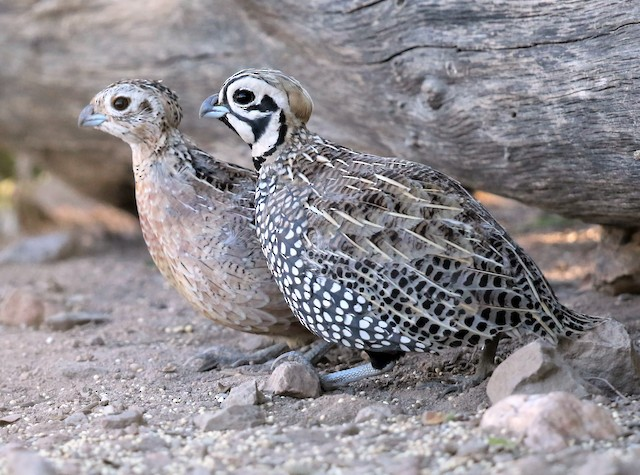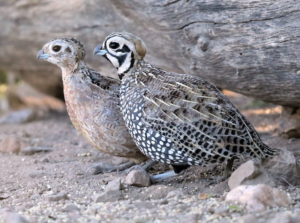The Montezuma quail, which also goes by Mearns’ quail, crazy quail, harlequin quail, black quail, painted quail, and fool’s quail, is a unique and rare bird species native to the southwestern United States and Mexico, with several populations in Texas. This elusive bird is known for its beautiful appearance and distinctive vocalizations. Unfortunately, the Montezuma quail is threatened with extinction due to habitat loss, predation, hunting, and climate change. We’re diving into what makes this bird so fascinating, the threats to its survival, the legal protection and conservation efforts, and how Texas landowners can help preserve this beautiful bird species.
Characteristics: Distinct Markings and Vocalizations
The Montezuma quail is a plump, round bird with a short tail and a distinct black-and-white facial pattern. The male has a colorful head with a red crest, while the female has a brown head with a white stripe above the eye.
The species is known for its distinctive vocalizations, including a series of whistled notes and clucking sounds.
The Montezuma quail has a unique life cycle and behavior. Breeding usually occurs in the spring and summer months, and males will use a variety of vocalizations and displays to attract females. Once a female is selected, she will lay her eggs in a shallow depression on the ground and incubate them for about 21 days. After hatching, the chicks are precocial, meaning they can move and feed on their own shortly after birth. The Montezuma quail is primarily a ground-dwelling species, and its feeding habits consist of various seeds, insects, and small plants. The species is not known to migrate but may move to different areas in response to changes in habitat conditions or food availability.
Where you can find Montezuma Quail in Texas
The Montezuma quail is found in various habitats, including grasslands, oak woodlands, and pine forests, but prefers areas with dense understory vegetation for cover, which is why In Texas, the Montezuma quail is found primarily in the western and southwestern regions of the state, including the Trans-Pecos and Edwards Plateau regions. The Montezuma quail is also adapted to the dry and arid conditions of the region. However, the species has experienced a decline in its Texas range due to habitat loss and fragmentation, making conservation efforts critical for its survival in the state.
Threats to the Montezuma Quail
This bird faces several threats to its survival, primarily habitat loss and fragmentation due to human activities that destroy its preferred dense understory vegetation reducing its ability to find cover and breed successfully. Other threats are:
- Predation by non-native species, such as feral cats and dog
- Natural predators like hawks and snakes
- Temperature and precipitation patterns can impact the availability of food and water sources.
- Hunting is another significant threat to the species, as it is a game bird in some states and can be hunted legally.
There is currently no open season for Montezuma quail in Texas. However, the Texas Parks and Wildlife Department classifies them as game birds because they are hunted in other states.
Protections in Texas
The Montezuma quail is a species of concern and is protected under federal and state laws protected under the Migratory Bird Treaty Act In Texas, the Montezuma quail is protected under state law as a non-game bird, prohibiting hunting and killing the bird without a permit. Additionally, the species is designated as a “Species of Greatest Conservation Need” by the Texas Parks and Wildlife Department, which has developed a conservation plan to guide efforts to protect and manage the species in the state. The conservation plan includes strategies such as habitat management, research, monitoring, and outreach and education efforts. The department also partners with private landowners and other organizations to implement conservation actions on private and public lands. They have established a voluntary landowner assistance program to provide technical and financial assistance to landowners interested in implementing conservation practices that benefit the Montezuma Quail and other wildlife species.
Here are some specific ways Texas landowners can play an important role in preserving the Montezuma quail and its habitat:
- Implement land management practices that promote the growth of native vegetation, such as prescribed burning and selective grazing
- Reduce threats to the quail by controlling non-native species and limiting human disturbance in key habitat areas.
- Participate in monitoring efforts and report sightings of the species to help improve knowledge of its distribution and abundance.
- Work with conservation organizations, such as the National Wild Turkey Federation and the Quail Coalition, to implement conservation practices on their land.
Learn More about the Montezuma Quail
To learn more about the rare and unique bird of Texas, here are some additional resources on wildlife management and conservation practices for Montezuma Quail:
- Texas Parks and Wildlife Department: https://tpwd.texas.gov/huntwild/wild/species/montezuma/
- The Oaks and Prairies Joint Venture: https://oaksandprairies.org/
- The Quail Coalition: https://quailcoalition.org/
- The Texas A&M AgriLife Extension Service: https://agrilifeextension.tamu.edu/
- The National Wild Turkey Federation – Texas Chapter: https://www.nwtf.org/about/state/texas










